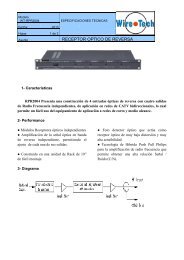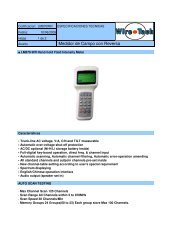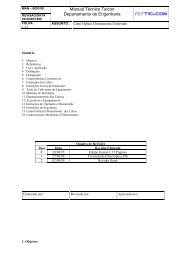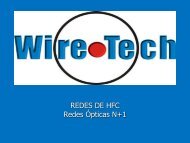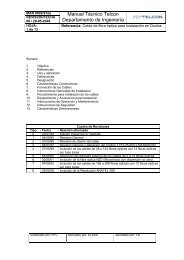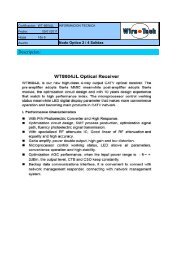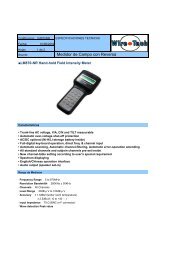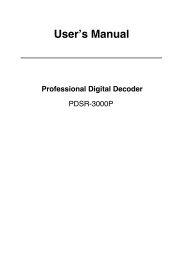Motorola BSR 2000 CMTS spec sheet - Capella ...
Motorola BSR 2000 CMTS spec sheet - Capella ...
Motorola BSR 2000 CMTS spec sheet - Capella ...
You also want an ePaper? Increase the reach of your titles
YUMPU automatically turns print PDFs into web optimized ePapers that Google loves.
Broadband Services Router <strong>2000</strong><br />
(<strong>BSR</strong> <strong>2000</strong>)<br />
Compact <strong>CMTS</strong>/Edge Router<br />
The Broadband Services Router <strong>2000</strong> (<strong>BSR</strong> <strong>2000</strong>) allows cable<br />
operators to generate incremental revenue, reduce operational cost,<br />
and more cost-effectively introduce voice, data, and video services to<br />
additional subscribers. This compact, high-performance Cable Modem<br />
Termination System (<strong>CMTS</strong>) is ideal for small- or medium-sized<br />
distribution hubs or for larger sites in the earlier stages of market<br />
penetration of broadband services.<br />
Operators can cost-effectively expand service areas while offering rich<br />
data, voice, and multimedia services. It offers advanced functionality<br />
that allows cable operators to efficiently migrate to DOCSIS® or<br />
EuroDOCSIS 2.0 while simultaneously increasing the performance of<br />
the existing base of DOCSIS 1.0 and 1.1 cable modems.<br />
It offers four upstream ports and includes RFSentry, which consists<br />
of a spare receiver port and the ability to implement Advanced<br />
Spectrum Management to monitor cable modem infrastructure without<br />
impacting service performance. Operators can implement sophisticated<br />
noise cancellation to meet the DOCSIS <strong>spec</strong>ifications so they can<br />
generate increased revenues, extend the life of installed modems, and<br />
deploy DOCSIS or EuroDOCSIS 2.0 cable modems at the pace that<br />
makes the most economic sense.<br />
The compact <strong>BSR</strong> <strong>2000</strong> can be deployed as a stand-alone unit or in<br />
small clusters to cost-effectively extend broadband access<br />
infrastructure to additional subscribers. This easy-to-use platform can<br />
help carriers develop a competitive edge in defining, deploying, and<br />
managing broadband services.<br />
Traffic flows from multiple <strong>BSR</strong> <strong>2000</strong>s can be aggregated by the<br />
carrier-class <strong>BSR</strong> 64000 to bring robust traffic management to a<br />
distributed environment. The <strong>BSR</strong> <strong>2000</strong> changes the value proposition<br />
for small or early stage broadband access network locations by<br />
offering a highly compact <strong>CMTS</strong> solution that can be installed in<br />
minutes to enable the cost-effective delivery of voice, data, and<br />
multimedia content and services.<br />
The <strong>BSR</strong> <strong>2000</strong> is a compact, high-performance<br />
DOCSIS® 2.0-qualified <strong>CMTS</strong> router that provides<br />
many of the robust features of <strong>Motorola</strong>’s<br />
award-winning <strong>BSR</strong> 64000 in a low-cost, highly<br />
dense platform. The <strong>BSR</strong> <strong>2000</strong> provides the<br />
greatest value in its catagory for broadband<br />
service providers delivering data, voice, and<br />
multimedia content and services.<br />
Highlighted Features:<br />
• DOCSIS® 2.0 and 1.1 qualified<br />
• PacketCable 1.0 compliant<br />
• Fully compatible with J-DOCSIS and EuroDOCSIS 1.0, 1.1, and 2.0<br />
<strong>spec</strong>ifications<br />
• Support for both A-TDMA and S-CDMA and for four logical<br />
channels, allowing the seamless introduction of DOCSIS 2.0 cable<br />
modems while enabling coexistence with 1.X cable modems<br />
• Ingress noise cancellation allows operators to optimize performance<br />
while operating in DOCSIS 1.0/1.1 and DOCSIS 2.0 mixed mode.<br />
• RFSentry functionality includes an extra receiver port to enable<br />
Advanced Spectrum Management so operators can monitor<br />
upstream performance while maintaining channel throughput<br />
• Architected for 1+1 system redundancy to support mission-critical<br />
applications—such as IP telephony—and can allow operators to<br />
increase overall service reliability and uptime<br />
• Full-featured routing with support for intradomain, interdomain, and<br />
multicast routing including OSPF v2, RIP v1/v2, BGP4, IGMP, and<br />
PIM-SM<br />
• Compact, space-saving 1RU platform can be installed in minutes by<br />
non-technical personnel<br />
• Supports Layer 2 forwarding and Layer 3 routing, as well as<br />
wire-speed packet classification and forwarding<br />
• Managed via SNMP v1 / v3, standard DOCSIS and IETF MIBs, and<br />
by a Command Line Interface (CLI)<br />
• SmartFlow® Quality of Service (QoS) classification for thousands of<br />
flows at wire-speed to enable Service Level Agreements (SLAs)<br />
• Built on the foundation of the award-winning <strong>BSR</strong> 64000, offering<br />
robust functionality proven in the most demanding HFC networks
BROADBAND SERVICES ROUTER <strong>2000</strong> (<strong>BSR</strong> <strong>2000</strong>)<br />
POWERFUL NOISE MEASUREMENT AND AVOIDANCE FEATURES<br />
The <strong>BSR</strong> <strong>2000</strong> provides ingress noise cancellation, post-equalization, sophisticated<br />
noise measurement, and noise avoidance capabilities. It offers the processing power<br />
and architectural support for adaptive ingress noise cancellation at the receiver.<br />
Diverse noise impairments are measured, analyzed, and cancelled out in real time.<br />
The platform supports policy-based routing, where routing is partially determined by<br />
in<strong>spec</strong>ting additional fields within the packet. For example, in applications where<br />
the operator generates wholesale revenue streams by providing multiple service<br />
provider access, the <strong>BSR</strong> <strong>2000</strong> can in<strong>spec</strong>t a source IP address and then route the<br />
traffic to the appropriate partner for handling.<br />
Post equalization capabilities offer the ability to increase the throughput of DOCSIS<br />
1.0 cable modems by allowing them to operate in 16 QAM mode virtually anywhere<br />
that it is possible to operate in QPSK. The <strong>BSR</strong> <strong>2000</strong> performs per-burst equalization,<br />
which enables the receiver to equalize—and thus correct for—the effects of<br />
micro-reflections, amplitude distortion, and group delay distortion.<br />
If the noise cannot be cancelled out—such as a very large ingress noise or<br />
interferer—the <strong>BSR</strong> <strong>2000</strong> can avoid the noise by changing the modulation mode or<br />
moving frequencies by performing intelligent frequency hopping.<br />
PARALLEL RECEIVER ENABLES NON-OBTRUSIVE MONITORING<br />
The unique RFSentry feature allows operators to improve performance of all DOCSIS<br />
modems. While four receivers per-system are available for servicing subscriber<br />
traffic, <strong>Motorola</strong> has uniquely architected an additional parallel receiver into the<br />
system to enable operators to monitor performance on any one of the upstream<br />
ports without materially impacting the subscriber experience.<br />
This receiver is connected in parallel with a selected receiver port so the operator<br />
can measure traffic and performance in real time on any given live receiver port. The<br />
parallel receiver can access all of the mapping information as well as a full list of<br />
cable modems available to whichever receiver port is currently being evaluated.<br />
Therefore, while the receiver port being monitored is performing its function at full<br />
capacity, the parallel receiver can non-obtrusively gain access to all of the return<br />
nodes connected to one of the receiver ports and perform tests on each upstream<br />
channel to assess its quality and take the time required to complete detailed,<br />
coherent SNR measurements.<br />
REDUNDANCY OPTION FOR HIGH-AVAILABILITY SERVICES<br />
The <strong>BSR</strong> <strong>2000</strong> architecture supports 1+1 redundancy to allow operators to offer high<br />
system availability by combining two units in a single location. This 1+1 system<br />
redundancy scheme offers a cost-effective, highly available solution for deploying<br />
mission-critical applications such as IP telephony in low penetration or emerging<br />
service areas.<br />
FULL-FEATURED ROUTING AT THE EDGE OF THE NETWORK<br />
The <strong>BSR</strong> <strong>2000</strong> offers a complete feature set in a small package, making it one of the<br />
most compact and versatile <strong>CMTS</strong>s in the industry.<br />
NETWORK MANAGEMENT AND CONTROL<br />
The <strong>BSR</strong> <strong>2000</strong> offers flexible options for efficient administration, management, and<br />
control to streamline deployment and operations costs. Various levels of<br />
custom-defined access privileges can be granted to administrators for management<br />
and troubleshooting. The <strong>BSR</strong> <strong>2000</strong> supports SNMP v1 and v3. <strong>Motorola</strong> supports all<br />
appropriate standard MIBs and offers custom MIBs to monitor and control the <strong>BSR</strong><br />
<strong>2000</strong>'s value-added features.<br />
The <strong>BSR</strong> <strong>2000</strong> also offers a Cisco®-compatible CLI for ease-of-use and<br />
interoperability with legacy infrastructure. The CLI supports full scripting capability,<br />
and ASCII-formatted command files can be uploaded, downloaded, and executed.<br />
SMARTFLOW QOS AND MULTI-SERVICE SUPPORT<br />
Broadband access networks are the foundation for new classes of entertainment<br />
and business services, including:<br />
•IP telephony<br />
•Interactive, multiplayer gaming<br />
•On-demand music, audio, and video<br />
•Tiered-data services<br />
•VPNs<br />
•Application hosting<br />
Provisioning these services over shared media requires robust QoS control to deliver<br />
the fine levels of service granularity required for real-time applications. Traditional<br />
solutions lack the wire-speed QoS capabilities, ingress noise cancellation, and<br />
<strong>spec</strong>trum analysis capabilities required to support diverse services The <strong>BSR</strong> <strong>2000</strong><br />
with SmartFlow allows per-flow policing and traffic shaping at wire-speed to provide<br />
unmatched abilities to offer customized QoS levels to enable SLAs.<br />
Operators can deliver QoS from the subscriber to a small distribution hub to the core<br />
backbone networks of multiple providers of services, applications, and content.<br />
SmartFlow allows operators to classify packets into flows based on packet content<br />
and provide the appropriate QoS treatment for each flow using DOCSIS for the<br />
upstream HFC network, hierarchical per-flow queuing for the downstream HFC<br />
network, and DiffServ for the metropolitan and core networks.<br />
Operators can deploy the <strong>BSR</strong> <strong>2000</strong> as a <strong>CMTS</strong> to support Layer 2 forwarding or<br />
Layer 3 routing. A full suite of routing protocols is supported, including carrier-class<br />
implementations of advanced routing protocols such as RIP v1 and v2, OSPF and<br />
BGP4. The <strong>BSR</strong> <strong>2000</strong> also supports IEEE 802.1q VLAN Tagging, which allows users to<br />
perform traffic separation for services such as Virtual Private Networks (VPNs).<br />
It also offers carrier-grade implementations of IP multicast protocols, including<br />
PIM-SM. It supports hundreds of Access Control Lists (ACL) while maintaining<br />
wire-speed routing capabilities.
BROADBAND SERVICES ROUTER <strong>2000</strong> (<strong>BSR</strong> <strong>2000</strong>)<br />
FLEXIBLE DEPLOYMENT APPLICATIONS<br />
This low-cost, high-value compact <strong>CMTS</strong>/edge router is based on a space-saving<br />
1RU platform and can be deployed for a wide range of operator requirements,<br />
including:<br />
Service Area Extension<br />
The <strong>BSR</strong> <strong>2000</strong> allows operators to minimize the costs and risks of extending the<br />
service area. It can be deployed at small distribution hubs to allow operators to<br />
cost-effectively add services to previously unserved locations. As the service<br />
becomes more broadly accepted, additional <strong>BSR</strong> <strong>2000</strong>s can be deployed or a<br />
carrier-class <strong>BSR</strong> 64000 can be deployed to the distribution hub, with the <strong>BSR</strong> <strong>2000</strong><br />
redeployed to extend the service area to an additional location.<br />
Feeders to Centralized <strong>BSR</strong> 64000s<br />
Traffic flows from multiple <strong>BSR</strong> <strong>2000</strong>s can be aggregated by a <strong>BSR</strong> 64000 to bring<br />
robust traffic management to a distributed environment. The <strong>BSR</strong> <strong>2000</strong> changes the<br />
value proposition for small broadband access network locations by offering a highly<br />
compact <strong>CMTS</strong> solution that can be installed in minutes to enable the cost-effective<br />
delivery of voice, data, and multimedia content and services.<br />
Differentiated Services<br />
Operators no longer need to deploy a chassis-based system to gain the benefits of<br />
full-featured routing at the network edge. The <strong>BSR</strong> <strong>2000</strong> allows broadband operators<br />
to rapidly introduce differentiated services for both corporate and residential<br />
subscribers. It offers the robust routing and the flexibility required to support the<br />
emerging generation of revenue-generating services, such as Voice-over-IP (VoIP),<br />
VPNs, and multimedia services.<br />
High-Availability Voice<br />
The <strong>BSR</strong> <strong>2000</strong> is PacketCable-based, and supports PacketCable features, including<br />
Dynamic Quality of Service (DQoS) for packet telephony QoS, the Common Open<br />
Policy Services (COPS) protocol for allowing network devices to communicate with<br />
Call Management Servers, and IPsec for secure communications between the<br />
distribution hub and various policy servers located at headends, such as CMS<br />
platforms. The <strong>BSR</strong> <strong>2000</strong> allows operators to meet CALEA requirements, and it<br />
includes support for prioritization of Enhanced 911 (E911) emergency service. The<br />
<strong>BSR</strong> <strong>2000</strong> supports per-flow queuing and provides the QoS control to support the<br />
demanding requirements of real-time voice services. They can optionally be<br />
deployed in redundant configurations so that operators can cost-effectively offer<br />
real-time, carrier-class voice services with minimal additional network investments.<br />
Hospitality and Multiple Dwelling Units<br />
Broadband providers can also deploy space-saving <strong>BSR</strong> <strong>2000</strong>s in hospitality locations<br />
or Multiple Dwelling Unit (MDU) facilities to extend broadband services. Just deploy<br />
a single, space-saving, 1RU <strong>BSR</strong> <strong>2000</strong> to provide broadband services to reach new<br />
subscribers located in an apartment house, condominium complex, or hospitality<br />
location.<br />
Multi-Tenant Units<br />
Operators can similarly deploy the <strong>BSR</strong> <strong>2000</strong> to support office parks, campus, and<br />
other multi-tenant units to offer voice, data, and multimedia services to<br />
small-to-medium size businesses.<br />
Wireless Integration<br />
Support for wireless broadband applications is also included in the platform, for<br />
those cable operators who need to extend their reach beyond the HFC plant so they<br />
can offer services using DOCSIS over wireless networks. The <strong>BSR</strong> <strong>2000</strong> has a<br />
separate Intermediate Frequency (IF) interface to support easy and cost-effective<br />
connection to wireless transmitters and receivers. The <strong>BSR</strong> <strong>2000</strong> allows them to<br />
offer wireless broadband services to customers where the cable plant is<br />
non-existent, such as in rural areas. The <strong>BSR</strong> <strong>2000</strong> can be integrated with wireless<br />
equipment to support high-speed data, voice, and streaming video services, enabling<br />
the MSO to attract subscribers in remote areas, where it is not otherwise<br />
economical to reach, by extending the cable plant.<br />
A B C D E<br />
F<br />
G<br />
H<br />
I<br />
J<br />
K<br />
L<br />
M<br />
N<br />
O<br />
P<br />
A. Bits Clock<br />
B. Ethernet Backbone Port (RJ-45)<br />
C. Ethernet Backbone Port (RJ-45)<br />
D. Gigabit Ethernet Backbone Port with SFP connectors<br />
E. On/off switch<br />
F. Dedicated Redundancy Port<br />
G. Ethernet Backbone Port (RJ-45)<br />
H. Ethernet Backbone Port (RJ-45)<br />
I. Gigabit Ethernet Backbone Port with SFP Connectors<br />
J. IF Port<br />
K. Downstream 0<br />
L. Upstream 0<br />
M. Upstream 1<br />
N. Upstream 2<br />
O. Upstream 3<br />
P. Power
SPECIFICATIONS*<br />
COMPACT <strong>CMTS</strong><br />
Form Factor<br />
1RU “Pizza Box”<br />
Height<br />
1.75” (44.4 mm)<br />
Weight<br />
20 Lbs (7.5 kg)<br />
Width<br />
19” (48.3 cm)<br />
Depth<br />
19.8” (50.3 cm)<br />
Power Input<br />
85 – 264 VAC, 47 – 63 Hz<br />
Power Consumption<br />
150 W<br />
Operating Temperature 0º C to 40º C (32º F to 104º F)<br />
Non-Operating Temperature –13º C to 70º C (–40º F to 158º F)<br />
Operating Humidity<br />
10 – 80% RH (non-condensing)<br />
Non-Operating Humidity<br />
5 – 95% RH (non-condensing)<br />
Air Flow front to back<br />
STANDARDS-BASED INTEROPERABILITY<br />
DOCSIS 2.0 and 1.1 qualified<br />
EuroDOCSIS 2.0 and J-DOCSIS compliant<br />
PacketCable 1.0 and EuroPacketCable 1.1 compliant: DQOS / IPSEC / COPS / CALEA<br />
NETWORK INTERFACES<br />
Two Gigabit Ethernet (SFP Module)<br />
Supported GE SFP Modules:<br />
1000-based SX Multimode<br />
1000-based LX Single Mode<br />
1000-based EX Single Mode<br />
1000-based ZX Single Mode<br />
1000-based TX RJ-45 Single Mode<br />
Four 10/100 Ethernet<br />
INTRADOMAIN / INTERDOMAIN ROUTING<br />
RIP v1<br />
RIP v2<br />
BGP4<br />
OSPF v2<br />
MULTICAST ROUTING SUPPORT<br />
PIM-SM<br />
IGMP v2<br />
NETWORK MANAGEMENT & PROVISIONING<br />
Cisco-compatible CLI<br />
SNMP v1 & v3<br />
Standard DOCSIS and IETF MIBs<br />
Telnet<br />
Secure Shell – SSH v2<br />
RADIUS<br />
TACACS+<br />
Multiple levels of account/password authentication<br />
DHCP Relay, including options 60 and 82<br />
Multiple community strings<br />
In-band and out-of-band management<br />
WIRELESS IF SUPPORT<br />
Output Frequency<br />
44 MHz<br />
FULL RF SPECTRUM SUPPORT<br />
DOCSIS, EuroDOCSIS and J-DOCSIS supported<br />
4 upstream DOCSIS receivers<br />
Downstream DOCSIS transmitter with integrated, managed upconverter for RF<br />
output<br />
Advanced Spectrum Management to enable reliable and high-quality service delivery<br />
Advanced ingress noise cancellation and post-equalization algorithms<br />
Unique, dedicated parallel receiver allows upstream <strong>spec</strong>trum monitoring without<br />
affecting channel throughput<br />
Upstream Modulation: QPSK, 16 QAM, 32 QAM, 64 QAM, 256<br />
QAM<br />
Upstream Per-Channel Bit Rate: 0.32 – 40.96 Mbps<br />
Upstream Input Frequency Range: 5 – 42 MHz DOCSIS<br />
5 – 55 MHz DOCSIS / J-DOCSIS<br />
5 – 65 MHz EuroDOCSIS<br />
Downstream Modulation:<br />
QPSK 1 , 16 QAM 1 , 64 QAM, 256 QAM<br />
Downstream Output Frequency Range: 88 – 857 MHz (channel center)<br />
Output Frequency Step Size:<br />
125 kHz<br />
BRIDGING AND ROUTING<br />
Layer 2 Forwarding<br />
VLAN Tagging<br />
Layer 3 Routing<br />
Policy-Based Routing (PBR)<br />
SmartFlow wire-speed forwarding and flow classification<br />
Hundreds of hardware-based ACLs for wire-speed packet classification and<br />
forwarding<br />
*Specifications are subject to change without notice.<br />
1 For Wireless DOCSIS Operation<br />
MGBI<br />
<strong>Motorola</strong>, Inc.<br />
Connected Home Solutions<br />
101 Tournament Drive<br />
Horsham, PA 19044<br />
USA<br />
US: +1.800.523.6678<br />
Outside the US: +1-215-323-1000<br />
www.motorola.com/broadband<br />
MOTOROLA and the Stylized M Logo are registered in the U.S. Patent and Trademark Office. RFSentry is a trademark and SmartFlow is a registered<br />
trademark of <strong>Motorola</strong>, Inc. DOCSIS is a registered trademark and PacketCable is a trademark of Cable Television Laboratories, Inc. Cisco is<br />
a registered trademark of Cisco Systems, Inc. All other product or service names are the property of their re<strong>spec</strong>tive owners. © <strong>Motorola</strong>, Inc.<br />
2006. All rights reserved.<br />
523578-001<br />
05/06–0K



